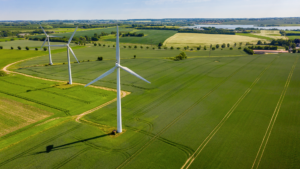 Green energy is any power source that doesn’t pollute and can be renewed through natural processes at a greater rate than it’s consumed. Oil, gas, and coal, for example, are technically renewable, but because they release carbon dioxide into the atmosphere and take millions of years to form, they’re not green. But if not all renewable sources are green, then what is green energy?
Green energy is any power source that doesn’t pollute and can be renewed through natural processes at a greater rate than it’s consumed. Oil, gas, and coal, for example, are technically renewable, but because they release carbon dioxide into the atmosphere and take millions of years to form, they’re not green. But if not all renewable sources are green, then what is green energy?
Wind
Wind is the largest green energy source in the United States, responsible for nine percent of the electricity we consume. Though wind is formed by air currents, it’s powered by the sun. Because of the Earth’s rotation and topography, sunlight doesn’t warm the planet evenly. It creates warm and cold zones instead. As warm air rises, cold air rushes in, creating wind.
Wind is the oldest green energy source in the world. Millers used it to grind flour for centuries. The Dutch used it to pump water and drain farmland. Modern wind turbines operate according to the same principles as their Medieval counterparts, though on a much larger scale. As the wind blows through the fan blades, it spins a turbine around a rotor, generating electricity.
Hydroelectricity
Hydroelectricity is the most common form of green energy outside the United States. It generates electricity by capturing kinetic energy from water as it flows from higher elevations to lower ones. To maximize energy per volume, it’s normally channeled through a narrow spillway. The force of gravity combined with the weight of water in reservoirs is incredibly powerful and can spin electric turbines at high speeds. Hydroelectric dams (the most famous is the Hoovr Dam) produce six percent of America’s electricity.
Solar Power
Solar panels are made of tiny photovoltaic cells, which convert sunlight into electricity. The top of each cell is seeded with phosphorus, giving it a slight positive charge, while the bottom is seeded with boron, giving it a slight negative charge. When sunlight hits the cell, it forces electrons from the top layer through the bottom layer, where they’re harvested and transferred to the electrical grid. Though the use of solar panels has grown tremendously, especially in urban areas, they still only generate three percent of our power.
Geothermal
Geothermal power plants produce electricity by tapping directly into the heat buried inside the Earth. They pump superheated water up from geothermal hotspots, which they convert to steam to power turbines. Because drilling is expensive, most geothermal plants are located in places like Iceland and Chile, where the mantle is particularly thin. Over 80 countries rely on geothermal energy, but, due to cost, it accounts for less than one percent of the electricity in the United States.
Clean but Not Green
There are two additional energy sources that are often classified as green, even though they don’t meet the definition. They both produce waste and may not be renewable. Nonetheless, many countries have adopted them because they’re significantly less harmful than fossil fuels.
- Biomass. Generates electricity by burning agricultural, urban, and industrial waste, such as wood chips and refuse. They can also be refined into biofuel to power cars. Biomass releases carbon dioxide, but only as much as it captures from the sun, making it potentially carbon-neutral. At the same time, it reduces the amount of garbage in landfills.
- Biogas. Biogas is a byproduct of agricultural, urban, and industrial waste. As organic products break down, they release methane. Burning methane creates carbon dioxide and water vapor, but removes a stronger greenhouse gas (methane) from the environment.
Biomass and biogas generate less than two percent of America’s electricity. While at the moment they’re renewable, it’s uncertain whether we could replenish them fast enough if they were used more widely.
Protecting Your Electrical System
Agway draws energy from multiple sources to power your home. While some of our producers still burn fossil fuels, others, like Sterling Planet, operate wind farms and hydroelectric plants, carefully offsetting all their carbon emissions in order to create a sustainable energy future.
What’s more, our EnergyGuardTM program ensures your home operates efficiently. It covers you in case your heating, cooling, or electrical systems break down. When a problem occurs, we contact a technician to get your home running again as soon as possible. There are no service fees or deductibles. We pay for all covered parts. You receive fast and reliable service. Customers are enrolled as soon as they join, so sign up and become a member today!